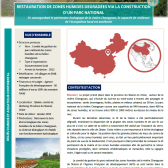River, which flows from southeast to northwest through diverse landscapes and ecosystems (mountains, forests, plains and urban environments) over 30 km. Changyuan River National Park covers an area of 948 hectares, including 460 hectares of wetlands, and is located between 800 and 1000 meters above sea level.
In recent decades, the riverbed has been particularly degraded, leading to the disappearance of most wetlands and its bed for more than 11 km. The river sand has been used by the glass industry, which is very well known in the city of Qixian. This river is of both ecological and cultural importance to the region. Its location in the large loess plains of central China, where wetlands are scarce, makes it a particularly important place from the point of view of biodiversity. This is why it was essential to restore the permanent river bed and the associated wetlands in order to allow the return of protected species, including some emblematic and threatened species, such as the black stork, golden eagle or mandarin duck.
The management committee of the Shanxi Changyuan River National Wetland Park and the Agence Française de Développement (AFD) have embarked on the river renaturalization and a sustainable management of its ecosystems. They relied on the technical expertise of Phytorestore, a company specializing in the treatment of pollution by plant, and landscaping design. By combining the creation of 2 protected areas, the reintroduction of local flora and the conservation of species and their habitats, the biological richness of the river has gradually been recovered. Ecotourism has also been developed to enhance the natural heritage.
Identification
Region of the world




